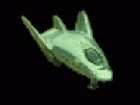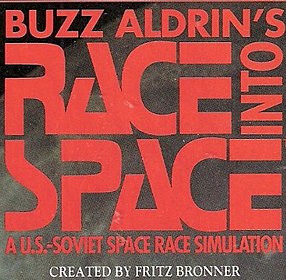Buzz Aldrin's Race into Space
| Buzz Aldrin's Race into Space | |||
|---|---|---|---|
| Lettering from the box cover | |||
| Studio | Strategic Visions | ||
| Publisher | Interplay | ||
| Senior Developer | Fritz Bronner, Michael McCarty | ||
| Erstveröffent- lichung |
1992 | ||
| platform |
MS-DOS (BARIS) Windows , Linux and Mac OS (RIS) |
||
| genre | Economic simulation | ||
| Game mode | Single player , multiplayer | ||
| medium | Floppy disk , CD-ROM , download | ||
| language | English | ||
| Current version | 1.01 (BARIS) 1.1 (RIS) |
||
| Age rating | |||
Buzz Aldrin's Race into Space ( BARIS for short ) is a turn-based business simulation (or a turn-based strategy game ) by Fritz Bronner and Michael McCarty from 1992 for the PC . In the game, the player assumes the role of the head of the space agency of the USA ( NASA ) or the USSR with the aim of realizing a manned moon flight in front of the opponent .
Gameplay
The game begins in the spring of 1957 and runs in rounds, each round lasts exactly six months. Before each round, the player is informed about the current status of the race into space via a television broadcast ; in addition to current information, world events from the respective time are briefly discussed.
The player's tasks include procuring material (such as rockets , spaceships , satellites, etc.), researching new technologies and improving existing equipment, as well as recruiting and training astronauts / cosmonauts . In addition, the player has to plan every single space mission. Through these missions, your own faction gains experience and prestige, which is reflected in budget increases. At the end of a round, the actual space mission is presented to the player. The game calculates whether a mission was successful based on factors such as the astronaut's level of training and the safety factor of the components used. The aim of the game is to be the first nation to land on the moon.
realism

The game attaches great importance to realizing space travel as realistically as possible in its beginnings. In addition to the original astronaut names, the game also uses countless photos and videos from NASA and Soviet archives. During the missions, the player can fall back on real space technology such as the Apollo spaceship, Atlas V and Saturn V rockets, satellites such as Sputnik or Ranger . The astronauts and cosmonauts also have the familiar names of the real space programs: Gagarin , Chrunow from the Soviet lunar program or Glenn , Slayton from the American Apollo program . In addition, the game also contains some vehicles that were not actually used: the Jupiter capsule or the Russian lunar module Kvartet . This gives the player the opportunity to make alternative moon landings ( direct moon landing , moon landing with the help of a space station).
The game relies on milestones in the missions , so a manned mission must take place before the first docking maneuver in space. If this does not happen, there are severe penalties on the safety factor of the spacecraft, which endangers the mission (and the lives of the astronauts).
history
Fritz Bronner developed the board game LIFTOFF in 1989! with Task Force Games and had the vision of a computer game implementation . Since the Task Force didn't have the rights, Liftoff! as a computer game, Bronner decided to do it on his own. In November 1990, he recruited Michael McCarty, then 22, as a programmer and founded Strategic Visions . The original development plan saw the Amiga as the target platform, for which a demo was created and published in June 1991. In September 1991, Strategic Visions concluded that the Amiga market was shrinking; it was decided to switch to the IBM PC as the target platform. In August 1991, Strategic Visions signed with Interplay Entertainment as publisher with May 1992 as the release date. At this time, the eponymous Apollo 11 astronaut , Buzz Aldrin , came into the project as an advisor. One of the results was the introduction of astronaut skills and morals, which could now influence the outcome of the mission.
Versions
The floppy disk version published in 1992 was criticized by many players because of its high level of difficulty and numerous program errors. Patch 1.01 therefore lowered the level of difficulty and corrected most of the errors. In 1993, Interplay released a CD-ROM version containing over 500MB of additional videos of missions and archive material. In Germany, this version was published as part of the Bestseller Games magazine series.
Release as freeware and the source code
The two developers, Fritz Bronner and Michael McCarty, had a contractual clause with their publisher Interplay Entertainment that provided for the revocation of the rights to the game to them if the company went bankrupt or the game was no longer sold. After the Interplay bankruptcy in 2004 and a long period of non-availability ( abandonware ), the two developers released the game themselves as freeware in 2005 and thus made it available again. In order to enable further development and porting (e.g. Pandora ) for the fan community, the original developers also made the source code available under the GPL . The source code of the further development project now called Race Into Space (RIS for short) is hosted on SourceForge and reached version 1.0 in 2011, the current version is v1.1.
reception
Although the game was advertised by Interplay and others as being suitable for children up to 10 years of age, there was criticism for its extreme difficulty level. The Guardian criticized the game as "pretty lifeless". Apart from that, the game was generally well received, it received 90% from PC Gamer UK , was a finalist for the COMPUTE! Choice Award 1993 and remained popular for years, so that in 2005 the original developers of Strategic Visions released the game as open source to the fan base.
See also
Web links
- Buzz Aldrin's Race into Space at MobyGames (English)
- Raceintospace Official advancement and ports for Windows, Linux and Mac
- The Docking Module Extensive active fan page for BARIS / RIS (English / French)
- BARIS at Abandonia.com (incl. Download option , English)
Individual evidence
- ↑ Allen Varney: The Buzz is Gone . In: The Escapist . No. 13, October 4, 2005, p. 2. Retrieved August 27, 2008.
- ↑ Bronner 1993 , p. 138
- ↑ Liftoff (English)
- ^ Fritz Bronner: The Buzz Aldrin's Race Into Space Companion . McGraw-Hill , Berkeley 1993, ISBN 0-07-881938-5 , p. 340.
- ↑ Staff: No More "Spam in a Can" Archived from the original on July 23, 2011. Info: The archive link was inserted automatically and has not yet been checked. Please check the original and archive link according to the instructions and then remove this notice. In: Golden Empire Publications (Ed.): Computer Gaming World . No. 90, Anaheim , January 1992, ISSN 0744-6667 , pp. 48, 50.
- ↑ CopyrightInfo.txt ( Memento of July 10, 2007 in the Internet Archive )
- ↑ race-into-space-v1-1-0-02-pandora-game-port (September 8, 2013, English)
- ↑ raceintospace on SourceForge .com
- ↑ ALL SYSTEMS ARE GO AS INTERPLAY LAUNCHES 'BUZZ ALDRIN'S RACE INTO SPACE' . Interplay Entertainment , PR Newswire . April 29, 1993. Retrieved August 20, 2008.
- ^ Scott A. May: Games that are good for you . In: Small System Services (Ed.): COMPUTE! . 16, No. 8, Greensboro, North Carolina , August 1994, ISSN 0194-357X , p. 90. Retrieved August 27, 2008.
- ^ Dorian Black: Aldrin takes a tame walk into space . In: The Age , June 1, 1993, p. 32. Retrieved August 24, 2008.
- ^ Jack Warner: Two new space programs inform while entertaining Interplay game is history lesson . In: The Atlanta Journal and Constitution , Oct. 24, 1993, p. P10. Retrieved August 24, 2008.
- ↑ John Minson: GAMES REVIEWS . In: The Guardian , June 10, 1993, p. 17. Retrieved August 24, 2008.
- ↑ Andy Butcher: Buzz Aldrin's Race Into Space . In: PC Gamer UK . Future plc . Archived from the original on May 23, 2002. Retrieved August 20, 2008.
- ^ Robert Bixby: Compute Choice Awards . In: Small System Services (Ed.): COMPUTE! . 15, No. 12, Greensboro (North Carolina) , December 1993, ISSN 0194-357X , p. 8.
- ↑ Race Into Space Project: Overview . Race Into Space Project. Retrieved August 28, 2008.
- ↑ Varney 2005 , p. 3



